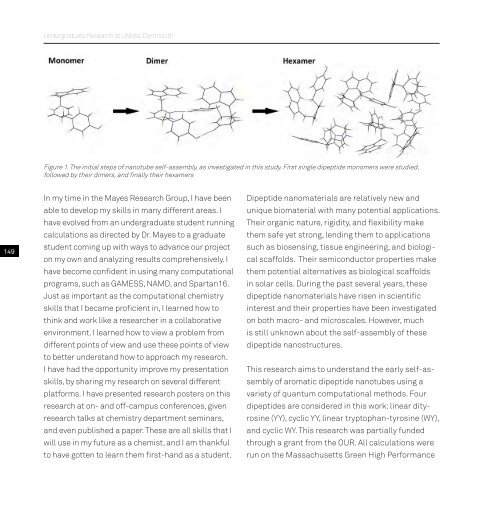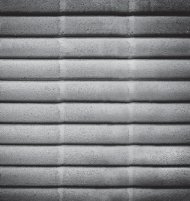Undergrad_Book_16-18_Pge_View_Print_no print marks_compressed
You also want an ePaper? Increase the reach of your titles
YUMPU automatically turns print PDFs into web optimized ePapers that Google loves.
<strong>Undergrad</strong>uate Research at UMass Dartmouth<br />
Figure 1. The initial steps of na<strong>no</strong>tube self-assembly, as investigated in this study. First single dipeptide mo<strong>no</strong>mers were studied,<br />
followed by their dimers, and finally their hexamers<br />
149<br />
In my time in the Mayes Research Group, I have been<br />
able to develop my skills in many different areas. I<br />
have evolved from an undergraduate student running<br />
calculations as directed by Dr. Mayes to a graduate<br />
student coming up with ways to advance our project<br />
on my own and analyzing results comprehensively. I<br />
have become confident in using many computational<br />
programs, such as GAMESS, NAMD, and Spartan<strong>16</strong>.<br />
Just as important as the computational chemistry<br />
skills that I became proficient in, I learned how to<br />
think and work like a researcher in a collaborative<br />
environment. I learned how to view a problem from<br />
different points of view and use these points of view<br />
to better understand how to approach my research.<br />
I have had the opportunity improve my presentation<br />
skills, by sharing my research on several different<br />
platforms. I have presented research posters on this<br />
research at on- and off-campus conferences, given<br />
research talks at chemistry department seminars,<br />
and even published a paper. These are all skills that I<br />
will use in my future as a chemist, and I am thankful<br />
to have gotten to learn them first-hand as a student.<br />
Dipeptide na<strong>no</strong>materials are relatively new and<br />
unique biomaterial with many potential applications.<br />
Their organic nature, rigidity, and flexibility make<br />
them safe yet strong, lending them to applications<br />
such as biosensing, tissue engineering, and biological<br />
scaffolds. Their semiconductor properties make<br />
them potential alternatives as biological scaffolds<br />
in solar cells. During the past several years, these<br />
dipeptide na<strong>no</strong>materials have risen in scientific<br />
interest and their properties have been investigated<br />
on both macro- and microscales. However, much<br />
is still unk<strong>no</strong>wn about the self-assembly of these<br />
dipeptide na<strong>no</strong>structures.<br />
This research aims to understand the early self-assembly<br />
of aromatic dipeptide na<strong>no</strong>tubes using a<br />
variety of quantum computational methods. Four<br />
dipeptides are considered in this work: linear dityrosine<br />
(YY), cyclic YY, linear tryptophan-tyrosine (WY),<br />
and cyclic WY. This research was partially funded<br />
through a grant from the OUR. All calculations were<br />
run on the Massachusetts Green High Performance



